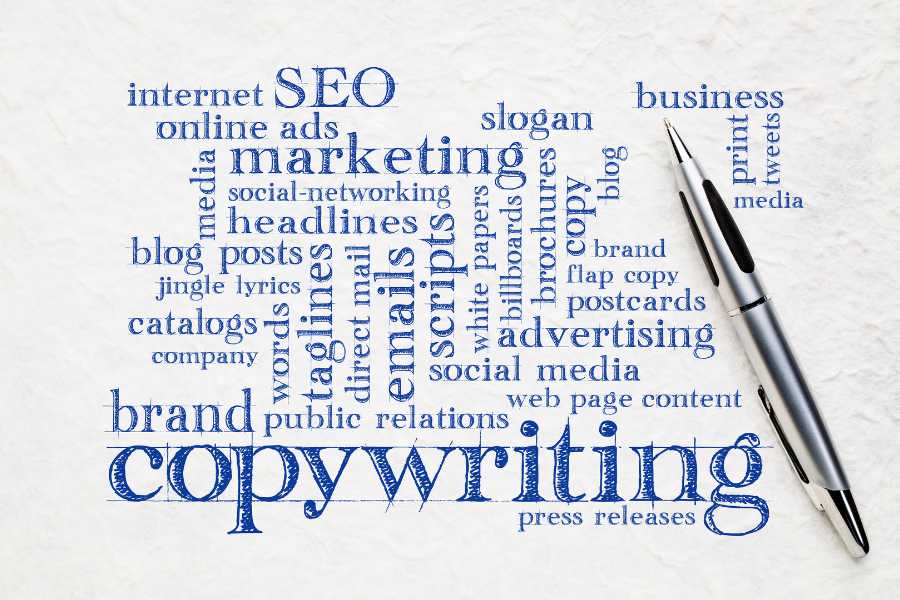What is copywriting, and how do you use it to make gobs of money?
If you’re asking yourself that question, you’re in the right place.
Since starting Smart Blogger, my copywriting skills have brought in over $15 million (yes, you read that right).
Many consider me one of the world’s best copywriters, and now I’m about to teach you all my tricks.
Everything from helping you understand what copywriting is to how to use your Godlike copywriting skills to get so filthy stinking rich you’re ashamed to tell anyone.
Let’s dive right in!

What is Copywriting?
Most definitions of copywriting are hopelessly stuffy and outdated, so here’s my personal personal take:
Copywriting is using words to grab people’s attention and convince them to do what you say.
Let’s say you are raising money for a dog shelter, and two different copywriters are going to email the donors list.
One copywriter gets $5000 in donations. The other copywriter gets $20,000.
The second copywriter is more effective.
Why? Because the goal was to get more donations, and the second copywriter finagled people into donating more.
It’s not about the beauty of the words. It’s not about creativity. It’s not about which email people liked the best.
Great copy is about talking people into doing stuff using nothing but your words.
To do that, you have to get their attention, build trust, and then give them a “call to action” (copywriting-speak for telling people what to do).
Many times, you are telling them to give you money, but not always. It can be anything that moves the sale forward, including clicking a link, liking a social media post, or opening an email.
What’s the Difference between Copywriting and Content Writing?
Different beasts, same jungle.
They’re often mistaken for twins, but understanding their differences is crucial for crafting effective copy.
Copywriting aims to drive immediate action. It’s the art of crafting:
- Compelling headlines
- Snappy slogans
- Punchy ad copy
- Calls to action
Think advertisements, sales letters, opt in pages, and email campaigns.
Want clicks? Need sales? Call the copywriter.
Playing the long game? Enter content writing.
It’s all about:
- Providing value
- Building trust
- Establishing authority
Ever read a blog post about meditation benefits? Or an in-depth guide on investing? That’s content writing at work. It educates, informs, and engages without the hard sell.
Which Should You Choose?
Here’s the truth: you need both.
Copywriting gets quick results. Content writing builds lasting relationships. They’re tools in your toolbox, each with its own strengths.
These days, writers are expected to specialize in one been at least basic skills with the other. If you don’t have both in your writing portfolio, you will notice it’s noticeably harder to get freelance work.
Small business clients might depend on you to do both, where large businesses will want you to collaborate.
Let’s look at Airbnb’s marketing efforts. They need to attract both travelers and property owners, requiring a mix of immediate action and long-term engagement.
Freelance Copywriter Tasks:
- Craft Facebook ad headlines: “Turn your spare room into spare cash”
- Write website CTA buttons: “Start hosting”
- Create email subject lines: “Your next adventure is just a click away”
- Develop seasonal campaign taglines: “Live There”
Freelance Content Writer Responsibilities:
- Write detailed blog posts about popular travel destinations
- Create in-depth guides for new hosts on optimizing listings
- Develop articles on responsible tourism and Airbnb’s community impact
- Write scripts for long-form video content showcasing unique experiences
Notice the synergy?
The copywriter grabs attention and drives immediate action. The content writer builds brand authority and keeps users engaged long-term.
It’s a powerful combination. A potential host clicks an ad because of punchy copy, but it’s the detailed guide that convinces them to list their property.
That’s why many businesses have a team that includes both specialties.
5 Essential Types of Copywriting You Should Know

Copywriting comes in many shapes and sizes, each suited to different marketing strategies. Let’s explore some of them…
1. SEO Copywriting
Over my career, I’ve gotten over 200 million visitors from Google search results.
How? SEO copywriting.
Search Engine Optimization copywriting, leverages keywords — those commonly searched terms that your audience types into search engines — to improve a website’s visibility and ranking.
When done right, SEO copywriting doesn’t just sprinkle keywords here and there like a chef adding spices to a dish. Instead, it masterfully weaves these keywords into engaging, readable content that both human readers and search engines love.
Here’s an example. Let’s say your business sells eco-friendly yoga mats. An SEO copywriter might use keywords like “best eco-friendly yoga mats,” “sustainable yoga gear,” or “green yoga products” in blog posts, product descriptions, and landing page content.
But the magic doesn’t stop at keyword use.
An ace SEO copywriter understands the importance of keyword density — not stuffing too many keywords into the text, which could make it read awkwardly and potentially lead to penalties from search engines.
They also know how to craft a post to meet search intent – a term for the match between what people are searching for and the content they find.
And most of all, they interweave content that provides real value while also paying attention to all of the technical search details.
Remember, the goal of SEO copywriting isn’t just to rank high in search results. It’s also about creating content that offers real value to your audience.
2. Social Media Copywriting
Scrolling through your social feed and stopped by a compelling post? That’s social media copywriting. Social media copywriters are the wizards behind catchy tweets, Facebook posts, Instagram captions, and LinkedIn posts.
Social media copywriting isn’t just about crafting a charming line or two. It requires a deep understanding of each platform’s dynamics, audience preferences, and the art of writing concisely.
Many times, you will also be ghostwriting for a key spokesperson within the company. You’ll need to match their style.
It’s a rapidly expanding field if you can do it well. Here’s an interview I did with Dakota Robertson where he talks about making six figures as a social media copywriter:
The bottom line? if you love social media, this style of copywriting might be for you.
3. Technical Copywriting
Imagine trying to understand the mechanics of a new gadget without a manual.
Nightmare, right? That’s where technical copywriters step in.
They translate complex information into easy-to-understand language, creating user-friendly manuals, digestible white papers, and crystal-clear product descriptions.
Technical copywriting isn’t just about simplification, though; it’s also about precision. A great technical copywriter knows how to strike a balance between maintaining the accuracy of the technical details while keeping the language accessible to the target audience.
Consider the user manual of a new smartphone. The technical copywriter won’t just tell you to “turn the phone on.”
They’ll guide you through every step of the process, explaining where the power button is located, how long to press it, and what to expect once the device powers up. They turn daunting technical complexities into a smooth, user-friendly experience.
The magic of technical copywriting lies in its ability to enhance customer experience, reduce customer support issues, and contribute to the overall image of a brand as user-centric and reliable.
4. Email Copywriting
Ever received an email that you just couldn’t ignore? That happens thanks to email copywriting.
Email copywriters specialize in crafting engaging content for newsletters, promotional emails, and more. Their primary goal is to create compelling subject lines and body copy that readers can’t resist opening, reading, and clicking links.
Email copywriting is an art of balance. A superb email copywriter knows how to pique curiosity with an irresistible subject line, maintain interest with concise and engaging content, and persuade with a compelling call to action – all while avoiding sounding too salesy or pushy.
Consider a promotional email for an upcoming sale.
A good email copywriter won’t just announce:
“We’re having a sale.”
Instead, they might say:
Save 80% on our widgets for the next 48 hours!
They’ll craft a story around the sale, evoke the reader’s anticipation, and ultimately, motivate them to click through and shop.
With effective email copywriting, you can foster a deep connection with your audience, boost your email open and click-through rates, and significantly increase conversions. It’s the key to making every email count in your marketing strategy.
5. B2B Copywriting
Business to business copywriting might be the easiest type of copywriting to start making big bucks.
It’s everything from crafting landing pages for corporate products to writing cold emails to grab the attention of executives who might be customers.
This form of copywriting calls for a distinct voice — one that can speak the language of business, understand industry-specific challenges, and present clear-cut solutions.
Imagine a company selling customer relationship management (CRM) software to other businesses.
First, you might write cold emails to the marketing directors to grab their attention.
When they reply, you might send them to a landing page.
You might urge them to download a white paper.
You might create ads for retargeting them as they browse the web to remind about you.
All of these tasks are done by a B2B copywriter
And the sales are usually high-ticket. Thousands or even tens of thousands of dollars per sale.
This gives businesses large budgets to spend on copywriting.
How Can You Start Copywriting?
It is super easy field to get into. Writing good copy doesn’t necessarily require an English degree or being a creative writing savant.
Instead, it hinges on understanding your audience, mastering the art of persuasion, and relentlessly refining your copywriting skills. So, consider the following:
- Study great copy: Step into the shoes of your favorite brands. Read their advertisements, their emails, their social media posts. Dissect their words. Why does their copy work? What emotions does it trigger? How does it prompt you to act? Absorb their strategies and adapt them to your style.
- Practice, practice, practice: Writing, like any other skill, improves with practice. Start by writing small ad copies, email subject lines, or even social media captions. Focus on making your words persuasive and engaging. As the saying goes, “write drunk, edit sober.” Get your ideas down, then refine them.
- Seek feedback and learn: Show your work to others. A fresh pair of eyes can provide valuable perspective. Listen to the feedback, learn from it, and iterate your writing.
- Understand your audience: Get into the mind of your readers. What motivates them? What are their needs, their desires, their fears? Once you know your audience, you can tailor your message to resonate with them.
- Stay updated: Copywriting trends evolve just like everything else. Stay current with industry news, attend workshops, participate in webinars and online courses. The more you know, the better you become.
Remember, the key to writing effective copy lies in your understanding of your readers and what drives them.
With these steps in your toolbelt, you’re well on your way to making a mark in the realm of copywriting.
Looking to Hire a Copywriter?

Hiring a copywriter isn’t just about finding someone who can string together beautiful sentences. It’s about bringing on board a strategic thinker, a listener, a word magician who can capture your brand’s essence and project it out to your audience.
- Understand your needs: Are you looking for someone to write SEO-heavy blog posts, engaging social media content, or persuasive product descriptions? The type of copy you need will guide your hiring process.
- Look for a good listener: A good copywriter listens before they write. They should be able to grasp your brand, your audience, and the message you wish to convey.
- Review their portfolio: A look at their past work can provide insight into their writing style, tone, and versatility. Do they adapt their writing to the brand they’re writing for? Can they convey complex information in a simple, engaging way?
- Consider their understanding of your industry: If you’re in a specialized industry, a writer with a solid understanding of your field may be advantageous. They’ll be able to craft copy that resonates with your specific audience.
- Check their SEO knowledge: With the rise of digital marketing, SEO has become an integral part of copywriting. A copywriter who knows how to strategically use keywords will be an asset.
- Test their skills: Consider setting up a small test project. This will give you a better sense of how they work, their creativity, and their ability to meet deadlines.
Hiring the right copywriter can make a significant difference to your content strategy. They can elevate your content, enhance your brand’s voice, and propel your marketing efforts forward.
Whether it’s crafting compelling ad copy, writing insightful blog posts, or improving your website copywriting, an adept copywriter is a priceless asset to any team.
Mastering the Art of Copywriting
So, you’ve made it this far.
Bet you’re thinking, “Copywriting sure does pack a punch, doesn’t it?”
And you’re absolutely right.
It’s like holding the keys to a kingdom, your kingdom, where words reign supreme.
But remember, mastering copywriting isn’t about outsmarting your reader; it’s about connecting with them, speaking their language, and sharing a story they can’t resist.
Ready to make waves with your words?




